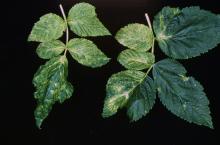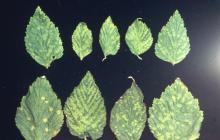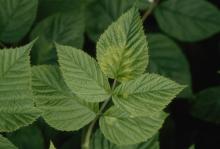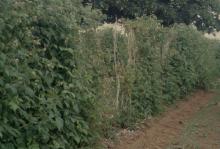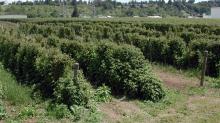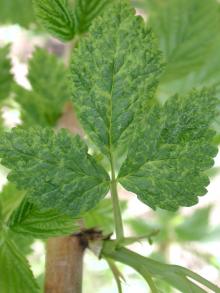See:
Raspberry (Rubus spp.) - Nematode, Dagger
Raspberry Cultivar Susceptibility
Cause Tomato ringspot virus (ToRSV), which is spread at a rate of about 6 ft. a year in the row by dagger nematodes (Xiphinema americanum and possibly related species. It is common in red raspberry in the northern Willamette Valley in Oregon and in Clark County in southern Washington. Besides red raspberry, the virus infects some cultivated and wild blackberries and raspberry-blackberry hybrids such as Boysen. The native hosts of ToRSV and the dagger nematode are numerous and include many common weeds such as dandelion and chickweed. These plants can serve as sources of inoculum in and around raspberry fields. The rate of natural spread is about 6 to 8 feet per year along the row, while the spread from row-to-row is slower. An infected nematode can transmit the virus to plant hosts for several months. Soil adhering to machinery can move the infected nematodes within fields and to other fields.
Symptoms Symptoms usually are most noticeable in newly infected plants. Leaf symptoms vary from mottled, chlorotic, mosaic leaves to leaf curling and ring spotting. Delayed emergence of primocanes may also occur. Infected plants often show no symptoms but have low vigor and yield. The virus also may cause crumbly fruit. On some cultivars it causes a severe dwarfing that resembles root-rot damage. Many red raspberry cultivars are susceptible; affected plants of Fairview die quickly. 'Canby', 'Puyallup', 'Meeker', 'Willamette' and probably most cultivars are susceptible to tomato ringspot virus and are severely weakened when affected.
Sampling Test new planting sites for dagger nematodes at least 1 year before planting.
Cultural control
- Do not plant in soil containing Xiphinema spp.
- Use certified planting stock.
- Fallow a site for 18 months prior to replanting to eliminate nematodes.
- Use a cover crop for a year that is a non-host for ToRSV such as sudan grass that allows the nematodes to multiply. This flushes the virus from the nematode.
Rogue out and destroy suspicious or diseased plants from fields once the presence of tomato ringspot virus has been confirmed. In addition to the diseased plants, rogue out at least the next five plants beyond the last plant in which you see symptoms because they probably are infected already. If more than 5% of the plants in a field are diseased, the value of roguing is doubtful.
- Clean equipment thoroughly between operations to remove soil-containing nematodes.
- Begin operations in fields that are not dagger-nematode-infested before moving to infested fields.
Control weeds such as dandelion. Establish a perennial grass in the alleyways to minimize soil movement on equipment. This greatly reduces the spread of tomato ringspot virus in the field.
- Maintain adequate fertility.
Reference Pinkerton, J.N., Kraus, J., Martin, R.R., and Schreiner, R.P. 2008. Epidemiology of Xiphinema americanum and tomato ringspot virus on red raspberry, Rubus idaeus. Plant Disease 92:364-371.


